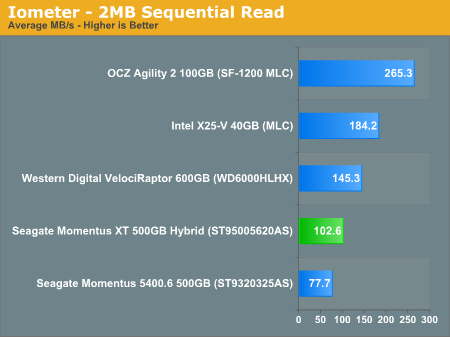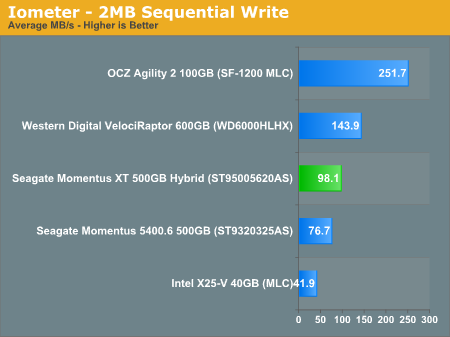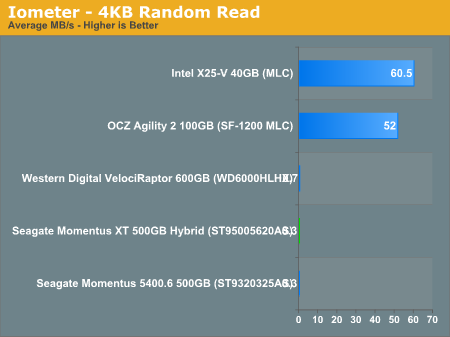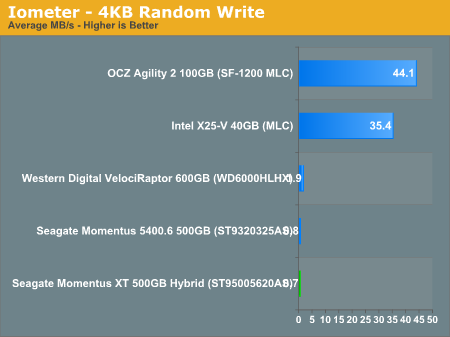Seagate's Momentus XT Reviewed, Finally a Good Hybrid HDD
by Anand Lal Shimpi on May 24, 2010 9:31 AM EST- Posted in
- Storage
- SSDs
- Seagate
- Momentus XT
- Hybrid Drive
- SSHDs
Sequential Read/Write Speed
Using the 6-22-2008 build of Iometer I ran a 3 minute long 2MB sequential test over the entire span of the drive. The results reported are in average MB/s over the entire test length:

Both sequential read and write speed are improved over the 5400.6 but we're still not in VelociRaptor territory. The X25-V is cripped in its write performance by comparison but most other SSDs do very well.

Random Read/Write Speed
This test reads/writes 4KB in a completely random pattern over an 8GB space of the drive to simulate the sort of random access that you'd see on an OS drive (even this is more stressful than a normal desktop user would see). I perform three concurrent IOs and run the test for 3 minutes. The results reported are in average MB/s over the entire time.

Random read/write performance is abysmal. You can't really make out the numbers here but that's 0.7MB/s for reads and 0.3MB/s for writes compared to 40MB/s+ for the SSDs. It's the poor random access performance that ultimately prevents the Momentus XT from feeling like an SSD most of the time.











120 Comments
View All Comments
wagsbags - Monday, May 24, 2010 - link
Most SSDs use wear leveling algorithms or compression or some other fairly complicated mechanism to ensure reliability. Seagate wanted to make this as simple as possible while still being reliable.codedivine - Monday, May 24, 2010 - link
Here is a request for a test. What happens in dual-boot scenarios? If I boot into Windows 7 and then lets say into Ubuntu, then I expect the drive will have some trouble determining what to cache in its relatively small 4GB NAND.teohhanhui - Monday, May 24, 2010 - link
"The drive looks at access patterns over time (most likely via a history table of LBAs and their frequency of access) and pulls some data into the NAND. If a read request comes in for an LBA that is present in the NAND, it's serviced out of the 4GB chip. If the LBA isn't present in the NAND, the data comes from the platters."It should not matter what OS you're using.
leexgx - Monday, May 24, 2010 - link
it works at an very low level at LBAbelow is simplified
if LBA 50 is accessed say 2 times or more it then gets added to the flash if LBA 50 is over written it invalidates the LBA 50 block from the flash (its bit more then what i have say but basically what it does)
this drive does not talk to the OS at all when putting stuff onto the flash it makes an history of what parts of the disk are accessed the most and puts it on the flash (FIle or not)
the disk does not care what OS is running as its only looking at the History of the LBA access on the hdd side of this drive, so there should no issues using these drives in raid as it works at the LBA level of whats accessed the most
even better as each drive has 4gb of cache on them and raid 0 spreads data across muti disks the flash can be 4gb x N1 so if you have 4 XT drives you have 16gb of read cache flash available so if you open or use upto 16gb of files/LBA blocks that norm never change and are in use often they be cached so most of the reads come from the flash and Writes would goto the disk (if an Write and read are going on often the spinning disk maybe often only Writing most of the time as the reads would come from the flash)
nafhan - Monday, May 24, 2010 - link
The hard drive's firmware controls what gets cached. If you went back and forth between two OS's, you'd probably end up with either one or neither of them cached. The article explains that the best case scenario for a hybrid drive is where your most frequently used applications can fit within the 4GB of flash memory.Exelius - Monday, May 24, 2010 - link
Any chance of seeing a desktop version of this drive?While I know you prefer the discrete SSD+RAID solution, there's something to be said for simplicity (from an end user perspective; at least.) I would personally love to see a 1TB drive with around 32 GB of NAND for around $200. Given that both 1TB drives and 32GB SSDs are available for under a bill, this should be doable, right?
And on a different note; I'd be interested in seeing how a similar drive with a much larger flash cache performs in an enterprise scenario. Would the sync algorithm kill performance? Or would a larger cache allow wear leveling to make up for an increase in IOPS?
YellowWing - Monday, May 24, 2010 - link
I second that! 1 TB disk with 32 GB NAND for a reasonable price in a 3.5 inch form factor would get my dollar. Even if it were only a read cache.GourdFreeMan - Monday, May 24, 2010 - link
32GB of SLC would push the price of such a drive beyond $400 once manufacturer’s margins are taken into account with current generation flash. If MLC could be used instead, the price might be pushed down into the $250 range for your hypothetical drive, but it would have to cache data far less frequently to avoid wearing out the flash (or have to include a real SSD-like controller and some extra flash as spare area, once again driving up the price).mwagers - Monday, May 24, 2010 - link
Hows the vibration? I am trying to find a HD for my macbook pro and cant seem to find a 7200 that doesnt vibrate the casing. How does this one fair?JohnnyComeLately - Monday, June 6, 2011 - link
I just put this drive in my 15" MacBook Pro. There is a slight increase, but it's very very slight. What I think you'll notice more over the OEM drive is the noise. When the fans are off, and I'm in a quiet room, normally my MBP makes nearly no noise. I can hear this Momentus' platter spinning. It's not obnoxious, bad, but you will notice it if you're in a quiet room.